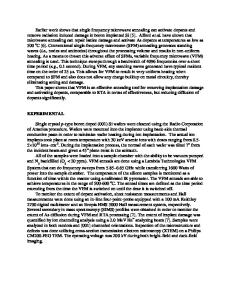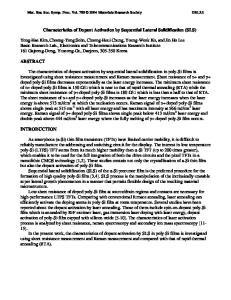Dopant Activation in Boron-Doped a-Si:H and a-SiC:H by Thermal Annealing and Light-Soaking
- PDF / 728,923 Bytes
- 12 Pages / 414.72 x 648 pts Page_size
- 27 Downloads / 353 Views
unclear. Therefore, we need more experimental evidence, including that with a-Si:H alloy, to understand the doping mechanism and its equilibrium behavior. In this paper, we focus on the effect of thermal history and light-soaking on boron-doped (p-type) a-Si:H and a-SiC:H in order to improve stability and reveal the mechanism of the dopant equilibrium, and we systematically study the effects on dark conductivity and consider the role of hydrogen in stability through the behavior of the dopant.
EXPERIMENTAL TECHNIQUES Boron-doped a-Si:H and a-SiC:H were deposited using a capacitively-coupled RF plasmaCVD method. Carbon and boron were introduced by adding CH4 and B2H6 , respectively, into3 SiH 4 of 10 sccm diluted with H2 of about 200 sccm. The optical bandgap, determined by ochv11 vs. hv plots, ranges from 1.53 to 1.87 eV. The samples were deposited on #7059 glass and crystalline silicon (c-Si) substrates at two different temperatures of 1 10°C and 180'C. The films on the #7059 glass were used for electrical conductivity measurements with co-planar Al electrodes and optical measurements, and those on c-Si were used for IR absorption measurements. The hydrogen bond configuration (SiH 2 /SiH) was measured by IR absorption spectra, and SiH 2 /SiH denotes the ratio of the integrated IR absorption coefficient for two peaks fitted with a Gaussian distribution at about 2000 and 2100 cm 1 . The carbon, boron and hydrogen content was measured by secondary ion mass spectroscopy (SIMS). The dark conductivity was measured at 25°C. Light-soaking tests were conducted under AM-1.5, 500 mWcm-2 light at 25°C.
EXPERIMENTAL RESULTS Effect of thermal annealing Thermal annealing for 1 H at 150'C was done for the samples deposited at 11 '0C.Figure 1 shows the relative change in dark conductivity after thermal annealing as a function of the CH 4 /SiH 4 ratio in the reaction gases. The annealing caused an increase in dark conductivity, and the increase is larger at a higher carbon content. The samples tested here have a wide range of boron-doping ratios (B2 H6/SiH 4 =0.05-5%). The data of the lower boron content samples show relatively large scattering, but the trend does not differ from the data of the higher boron content samples. These results suggest that dopant activation occurs more easily at a higher carbon content. In order to understand this phenomenon more precisely, the kinetics of the annealing process were measured for samples with three different carbon content values. Figure 2 (a), (b) and (c) show the change in dark conductivity at several annealing temperatures as a function of annealing time when CH 4 /SiH 4 is 2.0, 1.5 and 0, respectively. B2 H6/SiH 4 is 1-2% for all the samples. When CH 4 /SiH 4 is 2.0, the dark conductivity increases rapidly at relatively low temperatures and seems to saturate at the same value as shown in Fig. 2 (a). When CH 4 /SiH 4 is 1.5, the increase in the dark conductivity is slower than in the case of the higher content, as shown in Fig. 2 (b). Moreover, when CH 4 /SiH 4 is 0 (in the case of
Data Loading...









